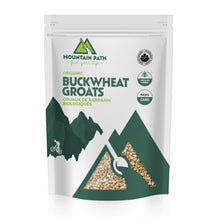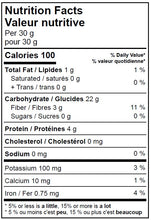Organic buckwheat groats are the hulled seeds of the buckwheat plant (Fagopyrum esculentum), a gluten-free pseudocereal. Despite its name, buckwheat is not related to wheat and is actually a seed, making it an excellent choice for gluten-free and plant-based diets. When labeled "organic," it means these groats are grown without synthetic pesticides, herbicides, or fertilizers, and processed without chemical additives.
Key Features of Organic Buckwheat Groats
- Appearance: Light green to beige in color, with a triangular or pyramid-like shape.
- Flavor: Mildly nutty and earthy; the flavor intensifies if roasted (as in kasha).
- Texture: Firm and chewy when cooked, or crunchy when toasted.
-
Nutritional Profile:
- Rich in Protein: Contains all nine essential amino acids, including lysine.
- High in Fiber: Supports digestive health and satiety.
- Packed with Micronutrients: Magnesium, manganese, copper, phosphorus, and B vitamins.
- Antioxidants: Contains rutin and quercetin, which help fight inflammation and oxidative stress.
Health Benefits
- Gluten-Free Alternative: Safe for those with celiac disease or gluten sensitivity.
- Heart Health: Rich in magnesium and rutin, buckwheat can support healthy blood pressure and cholesterol levels.
- Blood Sugar Control: Its low glycemic index helps stabilize blood sugar levels, making it suitable for diabetics.
- Digestive Support: High fiber content promotes regularity and gut health.
- Energy Boost: The combination of complex carbohydrates and essential nutrients supports sustained energy.
Uses of Organic Buckwheat Groats
Organic buckwheat groats are versatile and can be used in various dishes:
- Breakfast Porridge: Cooked groats make a hearty, gluten-free alternative to oatmeal.
- Salads: Add cooked or toasted groats for a nutty crunch in cold salads.
- Side Dishes: Serve as a base for grain bowls or as a rice substitute.
- Soups and Stews: Use to add texture and thickness.
- Baking: Incorporate into bread, muffins, or pancakes for added nutrition.
- Kasha: Toast the groats to enhance their nutty flavor, a traditional preparation in Eastern European cuisine.
Cooking Tips
- Rinse: Wash the groats thoroughly to remove any residual debris.
- Optional Toasting: Toast the groats in a dry skillet for a nuttier flavor before cooking.
- Cooking Ratio: Use 1 cup of buckwheat groats to 2 cups of water or broth.
- Cook Time: Simmer for about 10–15 minutes until tender. Avoid overcooking to prevent mushiness.
- Seasoning: Pair well with savory herbs, spices, or a touch of sweetness like honey or maple syrup.
Storage
- Dry Groats: Store in an airtight container in a cool, dry place for up to a year.
- Cooked Groats: Refrigerate in a sealed container for up to 5 days or freeze for longer storage.
Why Choose Organic Buckwheat Groats?
- Healthier Choice: Free from synthetic chemicals, ensuring a purer product.
- Environmental Benefits: Organic farming practices promote soil health and biodiversity.
- High-Quality Taste: Organic buckwheat often has a fresher, more robust flavor.
Organic buckwheat groats are a nutrient-packed, gluten-free staple that fits well into a variety of diets, from vegan to paleo. Their mild flavor, quick cooking time, and adaptability make them a fantastic choice for nutritious meals.




